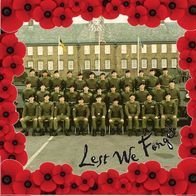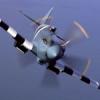-
Posts
671 -
Joined
-
Last visited
About plasmahal
- Birthday 08/12/1969
Profile Information
-
Gender
Male
-
Location
Warboys
Recent Profile Visitors
2,577 profile views
plasmahal's Achievements

Obsessed Member (4/9)
1.3k
Reputation
-
Invites going out ASAP.
-

1/48 Revell A10-A Thunderbolt II
plasmahal replied to plasmahal's topic in Work in Progress - Aircraft
UPDATE FOURAfter adding a few more minor parts, the A-10 was cleaned and primed with badgers black primer. -

1/48 Revell A10-A Thunderbolt II
plasmahal replied to plasmahal's topic in Work in Progress - Aircraft
UPDATE TWOThe cockpit has been completed now.I used Nato black to pick out the panels and some dry brushing to pick out details. UPDATE THREEPretty much got main assembly done.I added some riveting detail using some artistic licence. -

1/48 Revell A10-A Thunderbolt II
plasmahal replied to plasmahal's topic in Work in Progress - Aircraft
UPDATE ONESo i started on this build by deciding to remove the raised panel lines and replacing them with recessed panel lines.This was achieved by using scribing templates, tamiya curved masking tape and the UMM scribing tool.I assembled the engines and used styrene filler to sort gaps out. I used a lot of styrene filler on the intakes and the sanded heavily to get a nice smooth contour on the intakes. Then I stared on the cockpit and prayed it with Gunze H307.Leftover paint was used on the engine intakes to see how smooth they are. It show up a few pin holes that need filling. -

1/48 Bandai T-47 Snowspeeder.
plasmahal replied to plasmahal's topic in Ready for Inspection - SF & RealSpace
Thanks very much for the feedback guys. -
Background: The Fairchild Republic A-10 Thunderbolt II is a single-seat, twin turbofan engine, straight wing jet aircraft developed by Fairchild-Republic for the United States Air Force (USAF). Commonly referred to by its nicknames Warthog or Hog, its official name comes from the Republic P-47 Thunderbolt, a World War II fighter that was effective at attacking ground targets. The A-10 was designed for close-in support of ground troops, close air support (CAS), and providing quick-action support for troops against helicopters and ground forces. It entered service in 1976 and is the only production-built aircraft that has served in the USAF that was designed solely for CAS. Its secondary mission is to provide forward air controller – airborne (FAC-A) support, by directing other aircraft in attacks on ground targets. Aircraft used primarily in this role are designated OA-10. The A-10 was intended to improve on the performance of the A-1 Skyraider and its poor firepower. The A-10 was designed around the 30 mm GAU-8 Avenger rotary cannon. Its airframe was designed for durability, with measures such as 1,200 pounds (540 kg) of titanium armor to protect the cockpit and aircraft systems, enabling it to absorb a significant amount of damage and continue flying. Its short takeoff and landing capability permits operation from airstrips close to the front lines, and its simple design enables maintenance with minimal facilities. The A-10 served in Operation Desert Shield, and Operation Desert Storm, the American intervention against Iraq's invasion of Kuwait, where the A-10 distinguished itself. The A-10 also participated in other conflicts such as Operation Urgent Fury in Grenada, the Balkans, Afghanistan, Iraq, and against ISIL in the Middle East. Source: https://en.wikipedia.org/wiki/Fairchild_Republic_A-10_Thunderbolt_II Box and sprues:
-

Bandai 1/48 Snowspeeder.
plasmahal replied to plasmahal's topic in Work In Progress - SF & RealSpace
Hi, I used sheets of kitchen roll cut into quarters and cotton buds. Using those and slightly dampening them with water and using circular motions to take of excess wash. -
Background:The T-47 air-speeder was a model of low-altitude vehicle manufactured by Incom Corporation. When the Alliance to Restore the Republic was stationed on the icy planet of Hoth, a contingent of T-47 airspeeders were modified to become ground attack, low-altitude fighters called snowspeeders. A small, wedge-shaped craft, the Alliance snowspeeder was a two-man ship, with a pilot and a rear-facing tailgunner. It had two heavy, forward-facing laser cannons and a harpoon cannon fitted in its rear arc. During the Battle of Hoth, these snowspeeders used tow cables to easily take out All Terrain Armoured Transport walkers, by shooting the tow cable, and wrapping it out around the walker's legs, immobilising and destroying the walker. Source: http://starwars.wikia.com/wiki/T-47_airspeeder Kit Manufacture: Bandai. Scale: 1/48. Type: T-47 SnowSpeeder. Extras used: OOB. Paints and colours used: Primer was white Stynylrez. Paints used were Tamiya XF-2, XF-69, XF-63, XF-19, XF-55 and XF-57. Weathering: Flory Dark dirt clay wash.
-

Bandai 1/48 Snowspeeder.
plasmahal replied to plasmahal's topic in Work In Progress - SF & RealSpace
FINAL UPDATEThe crew have been painted and weathered appropriately.Ready for final reveal photos. -

Bandai 1/48 Snowspeeder.
plasmahal replied to plasmahal's topic in Work In Progress - SF & RealSpace
UPDATE TWOThe snowspeeder was cleaned over with some IPA.Then it was primed with badger's white primer.Then I used a mix of black and dark grey tamiya paints to add some pre-shading and mottling.Then a thin layers of a 3:1:1 XF-2, XF-19 and XF-55 mix was sprayed all over.This was followed up with some panels being highlighted with XF-2 and XF-57 in a 5:1 mix. Then other panels where picked out with just XF-57. The port air brake bay was masked off and sprayed NATO black.Alcald aqua gloss was applied and once dry, the decals added. This was followed up by some sponge chipping with a very dark grey. This was sealed with more aqua gloss.Then a dark dirt wash was applied.This was then cleaned off.After this, a matt coat was applied and final assembly completed. I sprayed the base with the badger white primer and left it that as the finish was very nice. -

Bandai 1/48 Snowspeeder.
plasmahal replied to plasmahal's topic in Work In Progress - SF & RealSpace
UPDATE ONESo after getting the cockpit sorted, main Assembly was pretty straight forward.All ready to prime and start the painting. -
Background: The North American F-86 Sabre, sometimes called the Sabrejet, was a transonic jet fighter aircraft. Produced by North American Aviation, the Sabre is best known as the United States' first swept wing fighter that could counter the similarly-winged Soviet MiG-15 in high-speed dogfights over the skies of the Korean War (1950–1953). Considered one of the best and most important fighter aircraft in that war, the F-86 is also rated highly in comparison with fighters of other eras. Although it was developed in the late 1940s and was outdated by the end of the '50s, the Sabre proved versatile and adaptable, and continued as a front-line fighter in numerous air forces until the last active operational examples were retired by the Bolivian Air Force in 1994. Its success led to an extended production run of more than 7,800 aircraft between 1949 and 1956, in the United States, Japan and Italy. Variants were built in Canada and Australia. The Canadair Sabre added another 1,815 airframes, and the significantly redesigned CAC Sabre (sometimes known as the Avon Sabre or CAC CA-27), had a production run of 112. The Sabre was by far the most-produced Western jet fighter, with total production of all variants at 9,860 units. F-86F Uprated engine and larger "6–3" wing without leading edge slats, 2,239 built; North American model NA-172 (F-86F-1 through F-15 blocks), NA-176 (F-86F-20 and −25 blocks), NA-191 (F-86F-30 and −35 blocks), NA-193 (F-86F-26 block), NA-202 (F-86F-35 block), NA-227 (first two orders of F-86F-40 blocks comprising 280 aircraft that reverted to leading edge wing slats of an improved design), NA-231 (70 in third F-40 block order), NA-238 (110 in fourth F-40 block order), and NA-256 (120 in final F-40 block order); 300 additional airframes in this series assembled by Mitsubishi in Japan for Japanese Air Self-Defense Force. Sabre Fs had much improved high-speed agility, coupled with a higher landing speed of over 145 mph (233 km/h). The F-35 block had provisions for a new task: the nuclear tactical attack with one of the new small "nukes" ("second generation" nuclear ordnance). The F-40 had a new slatted wing, with a slight decrease of speed, but also a much better agility at high and low speed with a landing speed reduced to 124 mph (200 km/h). The USAF upgraded many of previous F versions to the F-40 standard. Source: https://en.wikipedia.org/wiki/North_American_F-86_Sabre Kit Manufacture: Italeri. Scale: 1/32. Type: Sabre Jet F86-F Extras used: Aires cockpit ans wheel well sets.. Paints and colours used: Primer was black Stynylrez. Paints used were AK extreme metal black base, aluminium, dark aluminium and jet exhaust. Tamiya XF-7, XF-69 and Vallejo interior green 71.010. Weathering: Flory Dark dirt clay wash.
- 8 replies
-
- 22
-

-
Obligatory Box and sprue shots etc.Made a start on this nicely detailed little kit.Starting with the cockpit, I primed with badgers white primer and the based colour was tamiya German grey. This was dry brushed with vallejo barley grey. details were picked out with different colours. This was gloss coated and then given a dark dirt wash and cleanup.
- 11 replies
-
- 11
-

-
Hi,I have completed Airfix's 1/72 RAF Mustang IV as a quick 4 day build. Started on Thursday and finished today.Very easy and nice kit to build. Kit Manufacture: Airfix. Scale: 1/72. Type: RAF Mustang IV (North American P51-D).. Extras used: OOB. Paints and colours used: Primer was white Stynylrez. Paints used were Tamiya XF-4, XF-69, XF-81, XF-82, XF-83, XF-84, XF-85 and X-35. Weathering: Flory Dark dirt clay wash and some soot pigments on the engine exhausts.
- 9 replies
-
- 24
-

-
1/48 Fine Molds Mitsubishi KA-14 From The Wind Rises. Background: The Mitsubishi A5M, formal Japanese Navy designation Mitsubishi Navy Type 96 Carrier-based Fighter (九六式艦上戦闘機), experimental Navy designation Mitsubishi Navy Experimental 9-Shi Carrier Fighter, company designation Mitsubishi Ka-14, was a Japanese carrier-based fighter aircraft. It was the world's first monoplane shipboard fighter to enter service and the direct predecessor of the famous Mitsubishi A6M 'Zero'. The Allied reporting name was Claude. The Wind Rises (Japanese: 風立ちぬ Hepburn: Kaze Tachinu?) is a 2013 Japanese animated historical drama film written and directed by Hayao Miyazaki and animated by Studio Ghibli. It was released by Toho on July 20, 2013 in Japan, and by Touchstone Pictures in North America on February 21, 2014. The Wind Rises is a fictionalized biopic of Jiro Horikoshi (1903–1982), designer of the Mitsubishi A5M fighter aircraft and its successor, the Mitsubishi A6M Zero, used by the Empire of Japan during World War II. The film is adapted from Miyazaki's manga of the same name, which was in turn loosely based on the 1937 short story The Wind Has Risen by Tatsuo Hori. It was the final film directed by Miyazaki before his retirement in September 2013. The Wind Rises was the highest-grossing Japanese film in Japan in 2013 and received widespread critical acclaim. It won and was nominated for several awards, including nominations for the Academy Award for Best Animated Feature, the Golden Globe Award for Best Foreign Language Film, and the Japan Academy Prize for Animation of the Year. Source: https://en.wikipedia.org/wiki/Mitsubishi_A5M https://en.wikipedia.org/wiki/The_Wind_Rises Kit Manufacture: Fine Molds. Scale: 1/48. Type: Mitsubishi KA-14. Extras used: OOB. Paints and colours used: Primer was grey Stynylrez. Paints used were Tamiya X-13, XF-2, XF-58, XF-49, XF-69, XF-17, XF-7, XF-85 and AK Xtreme metal dark aluminium. Weathering: Dark dirt clay wash and some rust pigments on the engine exhausts. Build Thread: http://www.britmodeller.com/forums/index.php?/topic/235005189-148-fine-molds-mitsubishi-ka-14-from-the-wind-rises/
- 16 replies
-
- 22
-






